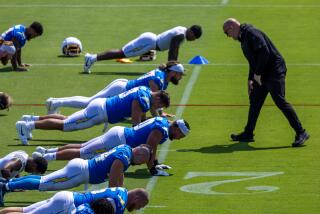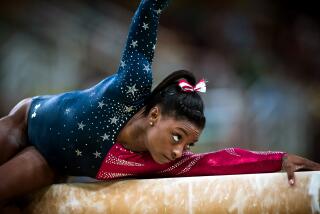Tough, Intimidating Look Is Mostly a Facade : Trainer Helps the Healing Process
- Share via
LONG BEACH — For a person who helps heal, he is intimidating.
He is larger than many of the football players he treats. His thick legs descend from gray corduroy shorts to sockless ankles. His blue shirt holds a muscular chest, his cheek a tobacco wad, his unsmiling lips a toothpick. The fluorescence of the room he works in is reflected in his creased skull.
But this tough look, as the athletes who put themselves in his sensitive hands know, is mostly a facade.
“At times I have to be intimidating,” said Dan Bailey, head trainer at California State University, Long Beach. He had just probed and massaged the sore lower back of a woman volleyball player after gently explaining to her his plan for treatment.
Bailey, 40, spends much of his time in a room full of tables, tape, whirlpools, exercise machines and devices labeled “bone-healing systems,” but he is most visible when he goes onto a field or court to aid an injured player. In that emotional moment--when the player is screaming and rolling around in pain--Bailey knows that intimidation and callousness can be necessary.
“Over the years, you try to develop a professional attitude toward injuries, so you don’t get involved with an athlete while doing an evaluation, even if he is a close friend,” said Bailey, in his 15th year as 49er trainer. “You have to be downright forceful at times. You have to tell them to shut their mouths, shock them back to reality to get some information out of them.”
A doctor normally is not present at 49er football or basketball practice sessions, and Bailey, although his years of experience have given him some diagnostic abilities, does not pretend to be one.
“One of the first things you learn in this business is that you don’t play doctor,” Bailey said. “(But) after a while you get such a feel (for the seriousness of an injury) by just looking or by talking to the player. I just make an observation, an assessment to help the doctor make the diagnosis.”
But sometimes Bailey will immediately tell a player that surgery probably will be needed.
“If I don’t know him well or I think he’s going to freak out, I won’t tell him and I’ll let the doctor handle it,” Bailey said.
“It’s the same with coaches. If I don’t know a coach well or respect him, I won’t tell him. That may be bullheaded, but that’s the way I am.”
Dr. Clifton Rose, who resigned this year as the 49ers physician, praises Bailey: “He’s excellent on injuries; his assessments are usually pretty accurate. I had complete faith in him.”
Rose refers to Bailey as a diamond in the rough. “He’s big and lumbering, the kind of guy you don’t expect to have the knowledge,” Rose said.
“But he’ll surprise you. He’s very intelligent, very competent in everything he does.”
Coaches tend to have less patience than Bailey with injuries.
“Coaches always put pressure on a trainer,” Bailey said. “They want to know, ‘Why is this person not playing?’ and ‘How long will he be out?’
“A trainer can have a real problem with a coach when he can tell the trainer the way things are,” Bailey said. “Then, a trainer can be gone if he doesn’t agree with the coach enough times. I answer directly to the athletic director, not a coach.”
Robert Donlan, the senior associate athletic director, said Bailey “makes sure athletes are well-healed before he puts them back on the field or court. “He won’t take a chance of risking injury.”
Bailey grew up in Wales, Utah, in a family that luxury never visited. His father was a dirt farmer and a coal miner who died in a mine when Dan was 11.
“We ate bread and milk for breakfast, lunch and dinner sometimes,” Bailey said.
He played defensive end and was a wrestler at the University of Utah in the late 1960s. His vocation was born when the Utah trainer showed him how to tape his teammates’ ankles.
Bailey, who has a certificate in physical therapy from USC, is co-owner and president of the Long Beach Sports Medicine and Physical Therapy Center, but his 49er job is what fills his time as well as most of his heart.
“With a healthy, motivated athlete, generally you see improvement weekly,” Bailey said. “That’s one good reason for working here. You tend not to get burned out so quickly.”
The 6-foot-2 Bailey takes on other challenges besides rehabilitating body parts. He has climbed Mt. Whitney three times. In 1986, he ran the Long Beach Marathon.
“When I walked off the football field in ‘69, I said I’d never run again,” Bailey said. “I didn’t for 15 years.”
His weight, now 220, reached 265.
“I had to do something,” he said, “because I enjoy taking a beer now and then.”
Started Running on a Bet
Bailey started running when a friend bet him that he could not run the Catalina 10-K race in less than an hour. He did, then began training for his first--”and last”--marathon.
“My running’s gone to pot,” Bailey said last week. “Yesterday I did three miles for the first time in three weeks.”
He knows well the emotions of sports. He has seen the joy and sorrow, heard the sound of profanity and helmets ricocheting off locker room walls. Former 49er football Coach Wayne Howard once kicked a hole in Bailey’s carrying case during a pregame speech, and Bailey saw a coach inspire his players by eating a newspaper article.
“If the job wasn’t fun, I’d quit,” he said. “I like the travel; I’ve gone places I’d never have gone otherwise.”
At 7:30 one recent morning, Bailey and his assistant, Keith Freeseman, taped ankles and gave treatments. Their day would not end until 8 p.m. The 15 student assistants from the university’s athletic training program had not yet arrived on campus, so Bailey had to push his creaky water cart out to the practice field himself.
“We go 90 m.p.h. in here,” said Bailey. Use of the training room has increased 500% since he came to Long Beach, mainly because of a rise in injuries.
“Athletes today tend to be in better shape,” he said, “but because they started (training) so early, their bodies just can’t hold out. And we’re starting to see that in women too.”
Pepper Jenkins, a sophomore linebacker from Lawndale, came into the training room. A surgical scar was on his left knee.
“Dan, how long will it be before I’m able to run?” Jenkins asked.
“Three to four months--we’re going to take it easy with you,” was the answer, but not the one Jenkins wanted.
Won’t Give False Hope
Jenkins, who had his knee reconstructed three months ago, and Gerald Woodyard, a freshman wide receiver also recovering from knee surgery, went out to the swimming pool. Bailey, ignoring their complaints, made them run, walk and swim across the pool several times.
“Players look at us as their means of getting back on the playing field,” Bailey said. “But the body has to heal itself. All we can do is help it along a little bit. Players want you to tell them they’ll be better than ever, but why give them false hope? I tell them the worst that can happen and the best and that probably they’ll end up somewhere in between.
“Pepper feels good and he wants to run, but I can’t let him do that. Those ligaments haven’t had a chance to heal.”
“If I do what Dan tells me, I’ll do all right,” Jenkins said.
If all goes well, Bailey will see Jenkins and Woodyard play football again. That is his greatest satisfaction.
More to Read
Go beyond the scoreboard
Get the latest on L.A.'s teams in the daily Sports Report newsletter.
You may occasionally receive promotional content from the Los Angeles Times.










